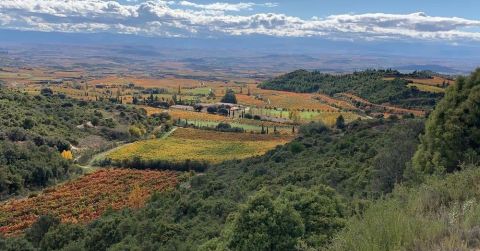From €21.50, 259 Swedish kronor, CA$36.75, 205.39 Danish kroner, 29.80 Swiss francs, 3,305 Serbian dinari, $33.59, £24.45, SG$75, 599 Chinese yuan
Surely the first quality of any desert-island wine – the single choice you are left to drink for all eternity – is that it comes in a suitably large format. If the scale of bottle in the image above existed, that might just about suffice, and indeed certain vintages of Remelluri's delicious Reserva Rioja are apparently available in handy 12-litre Balthazar bottles.
Even more important, however, is finding the wine that you would happily drink forever. Drinkability is Rioja's greatest asset, and, while Remelluri may not be the most mainstream example, their 2013 Reserva epitomises everything that makes Rioja great.
Remelluri is in the Rioja Alavesa subregion (see this map) at elevations between 590 and 805 m (1,935–2,640 ft). Owner Telmo Rodríguez, who grew up here and now produces several well-regarded wines around Spain, is focused on making a single-estate Rioja that reflects its terroir (the above photograph was taken from his Instagram feed).
As Julia observes in her 2015 tasting article on Rodríguez, 'Rioja has always seemed far more a brand – albeit a hugely popular and successful one – than a terroir wine, mostly made in large volumes by very large companies and generally from grapes that can come from anywhere in the entire appellation.'
Whereas at Remelluri, Rodríguez harks back to the archaic (for Rioja) model of smaller estates growing their own fruit. The result is still recognisably Rioja, but with firmer structure and darker fruit reflecting Remelluri's cooler, higher site. In a world of ever-earlier harvests, it is notable that Remelluri were still picking the tricky 2013 vintage as late as 4 November.
Organic farming is practised throughout the estate, and the vines have an average age of 40 years. Tempranillo is the main variety, comprising 85% of the 2013 Reserva, with 10% Grenache and 5% Graciano, and the resultant blend was aged for 21 months in a combination of French and American oak barrels.
The winemaking conforms with the norms, retaining the familiar, evocative sweet oak spice that is a signature of Rioja. Alongside it, the fruit tastes of autumnal brambles and there are, at eight years old, the first signs of age adding a little mulch and compost into the mix.
The result is instantly transportive, whisking you away to a place of rugged beauty and long, late-summer evenings. With its firmness of tannin and high-tensile fruit, it could comfortably mature for 20 years or more. Both of which happen to be vital qualities for a desert-island wine.
You'll find me under the palm tree. Now … wait a minute, where's the corkscrew?
Elements of main image courtesy of Leo Foureaux on Unsplash.
To discover more great Riojas, you'll find well over 1,500 tasting notes in our database.















